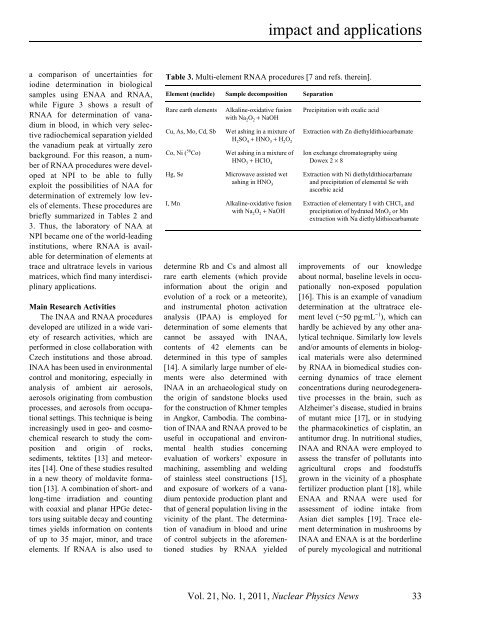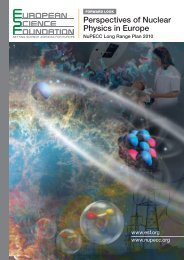Vol. 21 No. 1 - NuPECC
Vol. 21 No. 1 - NuPECC
Vol. 21 No. 1 - NuPECC
Create successful ePaper yourself
Turn your PDF publications into a flip-book with our unique Google optimized e-Paper software.
impact and applications<br />
a comparison of uncertainties for<br />
iodine determination in biological<br />
samples using ENAA and RNAA,<br />
while Figure 3 shows a result of<br />
RNAA for determination of vanadium<br />
in blood, in which very selective<br />
radiochemical separation yielded<br />
the vanadium peak at virtually zero<br />
background. For this reason, a number<br />
of RNAA procedures were developed<br />
at NPI to be able to fully<br />
exploit the possibilities of NAA for<br />
determination of extremely low levels<br />
of elements. These procedures are<br />
briefly summarized in Tables 2 and<br />
3. Thus, the laboratory of NAA at<br />
NPI became one of the world-leading<br />
institutions, where RNAA is available<br />
for determination of elements at<br />
trace and ultratrace levels in various<br />
matrices, which find many interdisciplinary<br />
applications.<br />
Main Research Activities<br />
The INAA and RNAA procedures<br />
developed are utilized in a wide variety<br />
of research activities, which are<br />
performed in close collaboration with<br />
Czech institutions and those abroad.<br />
INAA has been used in environmental<br />
control and monitoring, especially in<br />
analysis of ambient air aerosols,<br />
aerosols originating from combustion<br />
processes, and aerosols from occupational<br />
settings. This technique is being<br />
increasingly used in geo- and cosmochemical<br />
research to study the composition<br />
and origin of rocks,<br />
sediments, tektites [13] and meteorites<br />
[14]. One of these studies resulted<br />
in a new theory of moldavite formation<br />
[13]. A combination of short- and<br />
long-time irradiation and counting<br />
with coaxial and planar HPGe detectors<br />
using suitable decay and counting<br />
times yields information on contents<br />
of up to 35 major, minor, and trace<br />
elements. If RNAA is also used to<br />
Table 3. Multi-element RNAA procedures [7 and refs. therein].<br />
Element (nuclide) Sample decomposition Separation<br />
Rare earth elements<br />
Cu, As, Mo, Cd, Sb<br />
Co, Ni ( 58 Co)<br />
Hg, Se<br />
Alkaline-oxidative fusion<br />
with Na 2 O 2 + NaOH<br />
Wet ashing in a mixture of<br />
H 2 SO 4 + HNO 3 + H 2 O 2<br />
Wet ashing in a mixture of<br />
HNO 3 + HClO 4<br />
Microwave assisted wet<br />
ashing in HNO 3<br />
I, Mn Alkaline-oxidative fusion<br />
with Na 2 O 2 + NaOH<br />
determine Rb and Cs and almost all<br />
rare earth elements (which provide<br />
information about the origin and<br />
evolution of a rock or a meteorite),<br />
and instrumental photon activation<br />
analysis (IPAA) is employed for<br />
determination of some elements that<br />
cannot be assayed with INAA,<br />
contents of 42 elements can be<br />
determined in this type of samples<br />
[14]. A similarly large number of elements<br />
were also determined with<br />
INAA in an archaeological study on<br />
the origin of sandstone blocks used<br />
for the construction of Khmer temples<br />
in Angkor, Cambodia. The combination<br />
of INAA and RNAA proved to be<br />
useful in occupational and environmental<br />
health studies concerning<br />
evaluation of workers’ exposure in<br />
machining, assembling and welding<br />
of stainless steel constructions [15],<br />
and exposure of workers of a vanadium<br />
pentoxide production plant and<br />
that of general population living in the<br />
vicinity of the plant. The determination<br />
of vanadium in blood and urine<br />
of control subjects in the aforementioned<br />
studies by RNAA yielded<br />
Precipitation with oxalic acid<br />
Extraction with Zn diethyldithiocarbamate<br />
Ion exchange chromatography using<br />
Dowex 2 × 8<br />
Extraction with Ni diethyldithiocarbamate<br />
and precipitation of elemental Se with<br />
ascorbic acid<br />
Extraction of elementary I with CHCl 3 and<br />
precipitation of hydrated MnO 2 or Mn<br />
extraction with Na diethyldithiocarbamate<br />
improvements of our knowledge<br />
about normal, baseline levels in occupationally<br />
non-exposed population<br />
[16]. This is an example of vanadium<br />
determination at the ultratrace element<br />
level (~50 pg·mL −1 ), which can<br />
hardly be achieved by any other analytical<br />
technique. Similarly low levels<br />
and/or amounts of elements in biological<br />
materials were also determined<br />
by RNAA in biomedical studies concerning<br />
dynamics of trace element<br />
concentrations during neurodegenerative<br />
processes in the brain, such as<br />
Alzheimer’s disease, studied in brains<br />
of mutant mice [17], or in studying<br />
the pharmacokinetics of cisplatin, an<br />
antitumor drug. In nutritional studies,<br />
INAA and RNAA were employed to<br />
assess the transfer of pollutants into<br />
agricultural crops and foodstuffs<br />
grown in the vicinity of a phosphate<br />
fertilizer production plant [18], while<br />
ENAA and RNAA were used for<br />
assessment of iodine intake from<br />
Asian diet samples [19]. Trace element<br />
determination in mushrooms by<br />
INAA and ENAA is at the borderline<br />
of purely mycological and nutritional<br />
<strong>Vol</strong>. <strong>21</strong>, <strong>No</strong>. 1, 2011, Nuclear Physics News 33
















